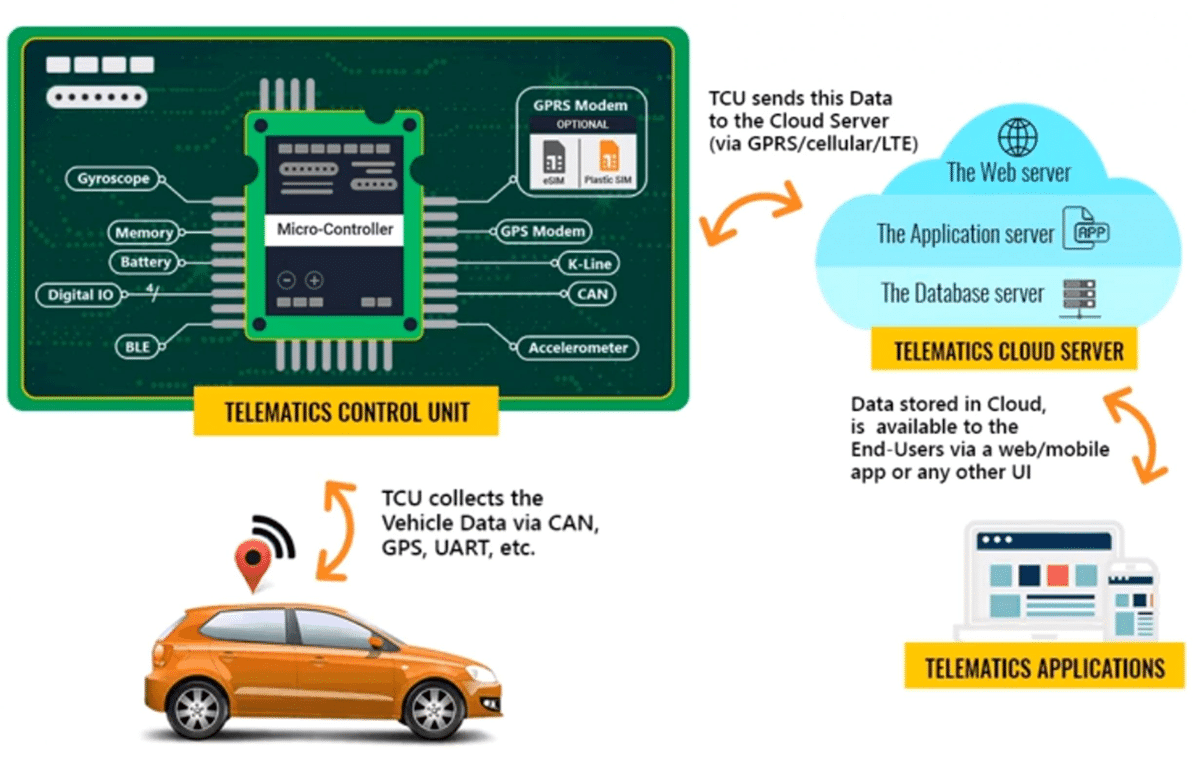
From safety alerts to seamless communication, A2P messaging is revolutionising driving, delivering real-time updates, and enhancing safety in connected vehicles.
The integration of electronics in automotive technology has transformed vehicles into intelligent, connected entities. A key advancement is the rise of application-to-person (A2P) messaging in connected vehicles, improving driving experience and introducing efficiency, safety, and convenience. The global automotive electronics market, valued at $272.3 billion in 2021, is projected to reach $415.6 billion by 2027, highlighting the growing demand for connected, electric, and autonomous vehicles. This underscores the crucial role of automotive electronics in shaping a technology-driven future for the automotive industry.

Significance of A2P messaging
A2P messaging is pivotal in the automotive industry, facilitating seamless communication between applications and users. It enables vital functions like vehicle diagnostics, maintenance alerts, and security notifications directly to users’ mobile devices. This enhances the customer experience with real-time updates on vehicle health, safety alerts, and personalised service reminders. A2P messaging streamlines customer engagement, promoting proactive maintenance and swift responses to critical issues, ultimately improving operational efficiency, user satisfaction, and safety through timely communication.
How connected vehicles and communication technologies impact the automotive industry
Connected vehicles and communication technologies integrate advanced systems to enhance safety, efficiency, and convenience. They enable vehicle-to-vehicle, vehicle-to-infrastructure, and external system communication, aiming to create an intelligent transportation system. This system aims to enhance traffic management, minimise accidents, and offer diverse services to drivers and passengers.
Integration of IoT in automotive systems
The incorporation of IoT in automotive systems is a transformative trend, giving rise to smart or connected vehicles. This technology utilises sensors, communication devices, and data analytics to improve the overall driving experience. Several aspects of IoT integration in automotive systems include:
• Real-time monitoring. IoT enables continuous monitoring of vehicle performance, allowing for immediate identification of issues and predictive maintenance
• Improved connectivity. Vehicles can seamlessly connect to the surrounding infrastructure, creating a cohesive network for improved safety and efficiency
• Data-driven insights. IoT integration provides valuable data on driving patterns, fuel consumption, and other metrics, facilitating data-driven decision-making for both drivers and manufacturers

Advancements in vehicle-to-everything (V2X) communication
Communication refers to the exchange of information between vehicles and any entity that may affect the vehicle, including other vehicles (V2V), infrastructure (V2I), pedestrians (V2P), and the network (V2N). Advancements in V2X communication technologies have the potential to significantly improve road safety, traffic efficiency, and overall transportation systems.
• Comprehensive connectivity. V2X communication encompasses V2V, V2I, V2P, and V2C, creating a holistic communication framework for vehicles within the transportation ecosystem
• Safety improvements. Vehicles share real-time information about traffic conditions, potential hazards, and road infrastructure, contributing to accident prevention and improved road safety
• Autonomous driving coordination. V2X enables vehicles to coordinate autonomous driving manoeuvres, increasing the capabilities of self-driving cars and ensuring smoother traffic flow
Role of A2P messaging in enabling seamless communication
A2P (application-to-person) messaging is essential for smooth communication across industries. It entails sending messages from applications to individuals, commonly via SMS and other messaging channels. Key aspects of A2P messaging in facilitating seamless communication include:
• Critical notifications. A2P messaging delivers important updates and notifications to drivers, such as traffic alerts, weather conditions, and maintenance reminders
• Personalised recommendations. Vehicles use A2P messaging to provide personalised recommendations for optimal routes, fuelling stations, and other relevant information
• Safety and convenience. A2P messaging ensures that drivers stay informed without distractions, contributing to both safety and convenience in the connected vehicle environment
Understanding A2P messaging
Application-to-person (A2P) messaging is a communication method where applications send messages to individuals. In the context of connected vehicles, A2P messaging plays a pivotal role in delivering timely and relevant information to drivers and passengers. This communication channel is instrumental in improving safety and providing valuable updates without causing distractions. Different types of A2P messaging in connected vehicles:
1. Alerts and notifications
• Safety alerts. A2P messaging delivers real-time safety alerts to drivers, including warnings about road conditions, accidents ahead, and potential hazards
• Maintenance reminders. Connected vehicles utilise A2P messaging to send proactive maintenance reminders, ensuring timely servicing, and preventing unexpected breakdowns
2. Remote vehicle control
• Lock/unlock commands. A2P messaging enables users to remotely lock or unlock their vehicles, increasing security and control
• Engine start/stop. Drivers can use A2P messaging to remotely start or stop their vehicles, offering convenience and climate control
3. Over-the-air (OTA) updates
• Software updates. A2P messaging facilitates the seamless delivery of OTA updates for in-vehicle software, ensuring that vehicles stay up-to-date with the latest features and security patches
• Firmware upgrades. Connected vehicles leverage A2P messaging to update firmware, improving the performance and capabilities of various onboard systems
4. In-vehicle entertainment and information
• Personalised recommendations. A2P messaging delivers tailored recommendations for in-vehicle entertainment options, such as music, podcasts, or nearby points of interest
• Traffic and navigation updates. Drivers receive real-time traffic updates and navigation suggestions, optimising routes for a smoother driving experience

Benefits of A2P messaging
A2P messaging plays a crucial role in the context of connected vehicles, providing various benefits that improve communication, safety, and user experience. Here are some key advantages:
1. Instant alerts and notifications. Receive real-time updates on traffic, weather, and maintenance, empowering drivers to make informed decisions on the go
2. Fleet management made easy. A2P messaging streamlines operations for businesses with vehicle fleets, optimising routes and scheduling maintenance seamlessly
3. Proactive driver assistance. Enjoy personalised suggestions for fuel-efficient routes, nearby amenities, and parking availability, increasing the overall driving experience
4. Emergency assistance and safety alerts. Automatic distress signals in emergencies ensure swift response, potentially saving lives and minimising road incidents
5. Convenient vehicle services. Manage vehicle well-being effortlessly, from scheduling maintenance appointments to receiving real-time updates on repairs
6. Minimised distractions. A2P messaging delivers crucial information without distracting drivers, keeping their focus on the road
7. Data-driven continuous improvement. Harness valuable data for analytics, refining offerings, improving safety features, and tailoring services to drivers’ evolving needs
Main components of A2P messaging
Messaging in connected vehicles involves communication between applications and users within the context of vehicle connectivity. This type of messaging is becoming increasingly important for various applications in connected vehicles, including safety alerts, navigation assistance, and vehicle diagnostics. Here are the main components:
1. Telematics unit. The telematics unit is a crucial component of connected vehicles. It comprises hardware and software that enable communication between the vehicle and external entities. This unit often includes sensors, GPS modules, and communication interfaces.
2. Connectivity. A2P messaging relies on robust connectivity, such as cellular networks (3G, 4G, and increasingly 5G) or wireless technologies like Wi-Fi. This ensures that the vehicle can communicate with external servers and applications in real time.
3. Messaging gateway. The messaging gateway acts as an intermediary between the vehicle and external applications. It manages the flow of messages, ensuring that they are delivered securely and efficiently. It may include protocols for message encoding and decoding.
4. Cloud platform. A cloud-based platform is often used to store and process the data exchanged between the vehicle and external applications. This platform facilitates the storage of vehicle data, analytics, and the deployment of applications or services.
5. Application servers. Application servers host the specific A2P applications that communicate with the connected vehicle. These applications can include navigation services, emergency response systems, remote diagnostics, and more.
6. Security mechanisms. Security is a critical aspect of A2P messaging in connected vehicles. Encryption, authentication, and secure communication protocols help protect the data transmitted between the vehicle and external servers, ensuring the privacy and safety of users.
Working of A2P messaging
Step 1. Data collection. The telematics unit collects data from various sensors within the vehicle, including GPS location, engine status, and other relevant information
Step 2. Message generation. Based on the collected data, messages are generated by the vehicle’s onboard systems or applications. These messages can include safety alerts, maintenance notifications, or any other relevant information.
Step 3. Communication with cloud platform. The vehicle communicates with the cloud platform through the messaging gateway using a secure connection. The cloud platform stores and processes the data received from the vehicle.
Step 4. Application interaction. External applications, hosted on application servers, interact with the cloud platform to retrieve relevant information or send commands to the connected vehicle. For example, a navigation application may send route updates to the vehicle.
Step 5. Message delivery to user. A2P messages are delivered to users through various channels, such as in-vehicle displays, mobile apps, or notifications. Users can receive real-time information, alerts, or updates from their connected vehicles.
Challenges in A2P messaging
A2P messaging for connected vehicles involves sending messages from applications or servers to the users of connected vehicles. While A2P messaging offers numerous benefits, it also faces several challenges in the context of connected vehicles.
1. Security concerns
- Data privacy. Connected vehicles transmit sensitive data, so safeguarding user privacy is crucial
- Cybersecurity. A2P messaging systems are vulnerable to cyber threats, necessitating robust security measures
2. Network reliability and coverage
- Global reach. Reliable A2P messaging across diverse regions with varying network infrastructures poses challenges
- Network congestion. High vehicle density can lead to delays in time-sensitive messages, impacting information delivery
3. Standardisation and interoperability
- Lack of standards. The absence of universal A2P messaging standards leads to interoperability issues
- Integration challenges. Seamless integration between automotive systems and messaging platforms requires standardised protocols
4. Regulatory compliance
- Data regulations. Adhering to varying data privacy regulations while delivering timely messages is challenging
- Emergency services compliance. Compliance with regulations for critical A2P communications, especially related to emergency services, is crucial
5. User consent and opt-in
- User permission. Obtaining and managing user consent for A2P messaging while respecting privacy is complex
- Opt-in challenges. Balancing user preferences and the need for relevant information while encouraging opt-ins is an ongoing challenge
6. Integration with in-vehicle systems
- Diverse ecosystems. Smooth integration with diverse in-vehicle systems without causing disruptions is a technical challenge
- Latency. Minimising latency for real-time communication, especially for safety alerts, is essential
Regulatory landscape in A2P messaging
Messaging is a dynamic framework designed to ensure the secure and ethical use of communication channels between applications and individuals. Governments and regulatory bodies worldwide have established guidelines to curb spam, fraud, and privacy breaches in A2P messaging. These regulations govern the use of short codes, long codes, and messaging routes, enforcing compliance with opt-in/opt-out procedures and content restrictions.
Key components of the regulatory landscape include the Telephone Consumer Protection Act (TCPA) in the United States, the General Data Protection Regulation (GDPR) in Europe, and similar laws in various regions. Adhering to these standards is crucial for businesses to maintain trust and protect user privacy. As technology evolves, regulatory frameworks adapt to address emerging challenges, fostering a responsible and secure environment for A2P messaging on a global scale.
Navigating the regulatory landscape is essential for the responsible deployment of A2P messaging in automotive electronics. The future holds exciting possibilities for A2P messaging in connected vehicles, with technological advancements poised to redefine the driving experience. As automotive electronics continue to evolve, A2P messaging stands as a key player in improving connectivity, safety, and overall user engagement on the road.
Dhaval Gajjar is CTO at Textdrip-A2P Messaging Platform and CEO of Pranshtech Solutions and We Technolabs. As a technology leader, he is dedicated to driving innovation and digital transformation in messaging platforms and technology solutions










